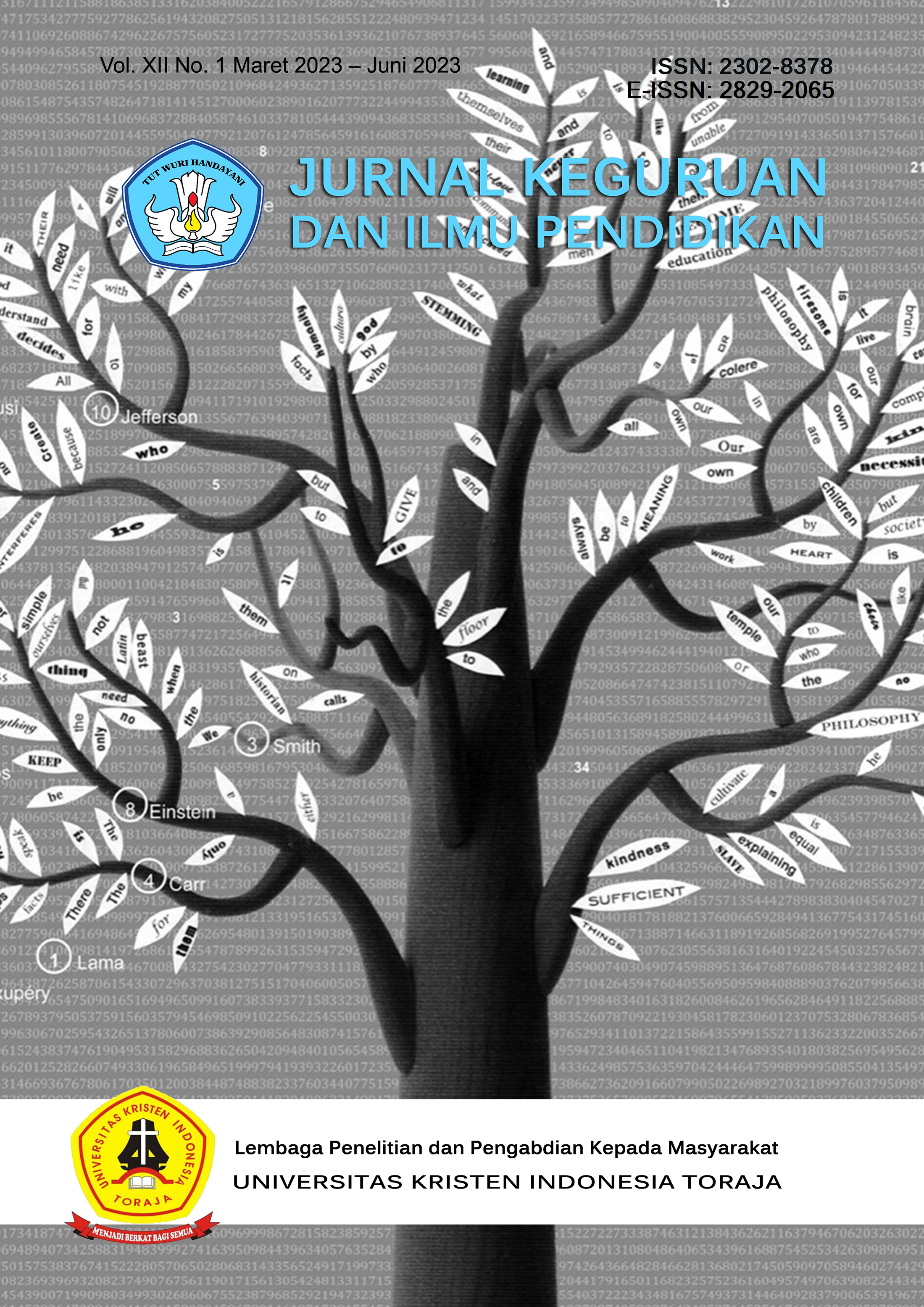Analisis Kesulitan Siswa dalam Menyelesaikan Soal Cerita Bilangan Pecahan
DOI:
https://doi.org/10.47178/jkip.v12i1.2050Keywords:
Story problems, fractionsAbstract
This research was carried out with the aim of knowing the causes of difficulties in solving fractional word problems in grade IV students. The approach used in this study is a qualitative approach with a qualitative description research type. The subjects of this study were teachers and 3 students at UPT SDN 1 Bittuang for the 2022/2023 academic year. Data collection techniques using observation, tests, interviews, and documentation. The data analysis technique used is the data reduction stage, the data presentation stage, and the conclusion drawing stage. The results of the study showed that the difficulty of solving fractional word problems in fourth grade students of UPT SDN 1 Bittuang consisted of three components, namely (1) difficulty solving problems in word problems such as lack of understanding of fractional word problems, not writing down what was known and asked to word problems, lack of accuracy in reading, and mistakes in mastering fraction material. (2) difficulty understanding the concept of fractions such as students having difficulty writing the numerator and denominator, unable to distinguish between the numerator and denominator, (3) and difficulties in arithmetic skills such as adding the numerator with the numerator, and the denominator with the denominator, making mistakes in changing mixed fractions into ordinary fractional numbers, miscalculations in addition operations, and not carrying out the calculation process.
Downloads
References
T. Tulak, S. S. Tangkearung, and R. Selin, “Analisis Kemampuan Berpikir Tingkat Tinggi Siswa pada Mata Pelajaran Matematika,” in Transformasi Nilai-Nilai Kearifan Lokal Berbasis Teknologi, Makale: UKI Toraja Press, 2022, p. 10. [Online]. Available: https://journals.ukitoraja.ac.id/index.php/PROSDING/article/view/1550/1151
B. Tanujaya and J. Mumu, HOTS dalam Pembelajaran Matematika: Komplikasi dan Analisis Hasil Penelitian. Depok: PT Raja Grafindo Persada, 2021.
M. Andayani and Z. Amir, “Membangun Self-Confidence Siswa melalui Pembelajaran Matematika,” DJM, vol. 2, no. 2, pp. 147–153, 2019, doi: 10.24042/djm.v2i2.4279.
J. Ferrini-Mundy, “Principles and Standards for School Mathematics: A Guide for Mathematicians,” vol. 47, no. 8, pp. 868–876, 2000.
M. Z. Mubarak, Anwar, and Susanti, “Proses Berpikir Siswa Terhadap Kemampuan Representasi Matematis Ditinjau Dari Gaya Belajar Visual,” JPPM, vol. 4, no. 2, p. 132, Dec. 2020, doi: 10.22373/jppm.v4i2.7998.
NCTM, Principles and Standards for School Mathematics. Reston: The National Council of Teachers of Mathematics, Inc, 2000.
I. F. Laily, “Hubungan Kemampuan Membaca Pemahaman dengan Kemampuan Memahami Soal Cerita Matematika Sekolah Dasar,” Jurnal EduMa: Mathematics Education Learning and Taching, vol. 3, no. 1, pp. 52–62, 2014.
E. Samhatul, A. Amaliyah, K. Khotimah, Nurhalisa, and W. Ananda, “Analisis Kesulitan Siswa dalam Memahami Soal Cerita Materi Pecahan Kelas Tinggi SDN Pondok Kacang Timur 03,” Jurnal Pendidikan Tambusai, vol. 6, pp. 10663–10668, 2022.
Y. Ansori and I. Herdiman, “Pengaruh Kemandirian Belajar terhadap Kemampuan Pemecahan Masalah Matematis Siswa SMP,” Journal of Medives?: Journal of Mathematics Education, vol. 3, no. 1, pp. 11–19, 2019, doi: https://doi.org/10.31331/medivesveteran.v3i1.646.
A. Rahman, T. Tulak, and Asdar, “Profil Pemecahan Masalah Matematika Berdasarkan Gaya Belajar Siswa Kelas VIII SMP Negeri 16 Makassar,” eprints.unm.ac.id, p. 16, 2017.
?. B. Ölmez and A. Izsák, “Characterizing reasoning about fraction arithmetic of middle grades teachers in three latent classes,” Mathematical Thinking and Learning, vol. 23, no. 3, pp. 225–253, Jul. 2021, doi: 10.1080/10986065.2020.1780368.
S. Ö. Bütüner, “A Comparison of the Instructional Content on Division of Fractions in Turkish and Singaporean Textbooks,” International Journal of Mathematical Education in Science and Technology, vol. 51, no. 2, pp. 265–293, Feb. 2020, doi: 10.1080/0020739X.2019.1644681.
M. A. Alkhateeb, “Common Errors in Fractions and the Thinking Strategies That Accompany Them,” INT J INSTRUCTION, vol. 12, no. 2, pp. 399–416, 2019, doi: 10.29333/iji.2019.12226a.
T. Tulak, W. Rianto, V. Stevania, and Rubianus, “Analysis of Misconception of Elementary School Teacher Study Program UKI Toraja Lectures about Fraction,” Edumaspul: Jurnal Pendidikan, vol. 6, no. 2, p. 8, 2022, doi: 10.33487/edumaspul.v6i2.4139.
L. Hea-Jin and I. Boyadzhiev, “Underprepared College Students’ Understanding of and Misconceptions with Fractions,” INT ELECT J MATH ED, vol. 15, no. 3, pp. 1–12, 2020, doi: 10.29333/iejme/7835.
C. Janvier, “Problems of representation in the teaching and learning of mathematics,” Lawrence Erlbaum Associates, Inc., 1987.
M. Koopman, M. Thurlings, and P. den Brok, “Factors influencing students’ proficiency development in the fraction domain: the role of teacher cognitions and behaviour,” Research Papers in Education, vol. 34, no. 1, pp. 14–37, Jan. 2019, doi: 10.1080/02671522.2017.1390595.
D. Sulle and T. Tulak, “Pengaruh Keterampilan Mengajar Guru Terhadap Motivasi Siswa pada Pembelajaran Tematik,” Jurnal Keguruan dan Ilmu Pendidikan, vol. 10, no. 1, p. 6, 2021, doi: 10.0901/jkip.v10i1.1167.
T. Tulak, “Peran Guru Dalam Menanamkan Nilai-Nilai Karakter Pada Pembelajaran Kurikulum 2013,” Jurnal Keguruan dan Ilmu Pendidikan, vol. 9, no. 3, p. 7, 2020.
Sugiyono, Metode Penelitian Kuantitatif, Kualitatif, Dan R&D. Bandung: PT. Alfabeta, 2017.
M. B. Miles, A. M. Huberman, and J. Saldaña, Qualitative Data Analysis. A Methods Sourcebook, 3 rd. Los Angeles, London, New Delhi, Singapore, Washington DC: SAGE Publications, 2014.
N. Anditiasari, “Analisis Kesulitan Belajar Abk (Tuna Rungu) Dalam Menyelesaikan Soal Cerita Matematika,” Mathline?: Jurnal Matematika dan Pendidikan Matematika, vol. 5, no. 2, pp. 183–194, 2020, doi: 10.31943/mathline.v5i2.162.






